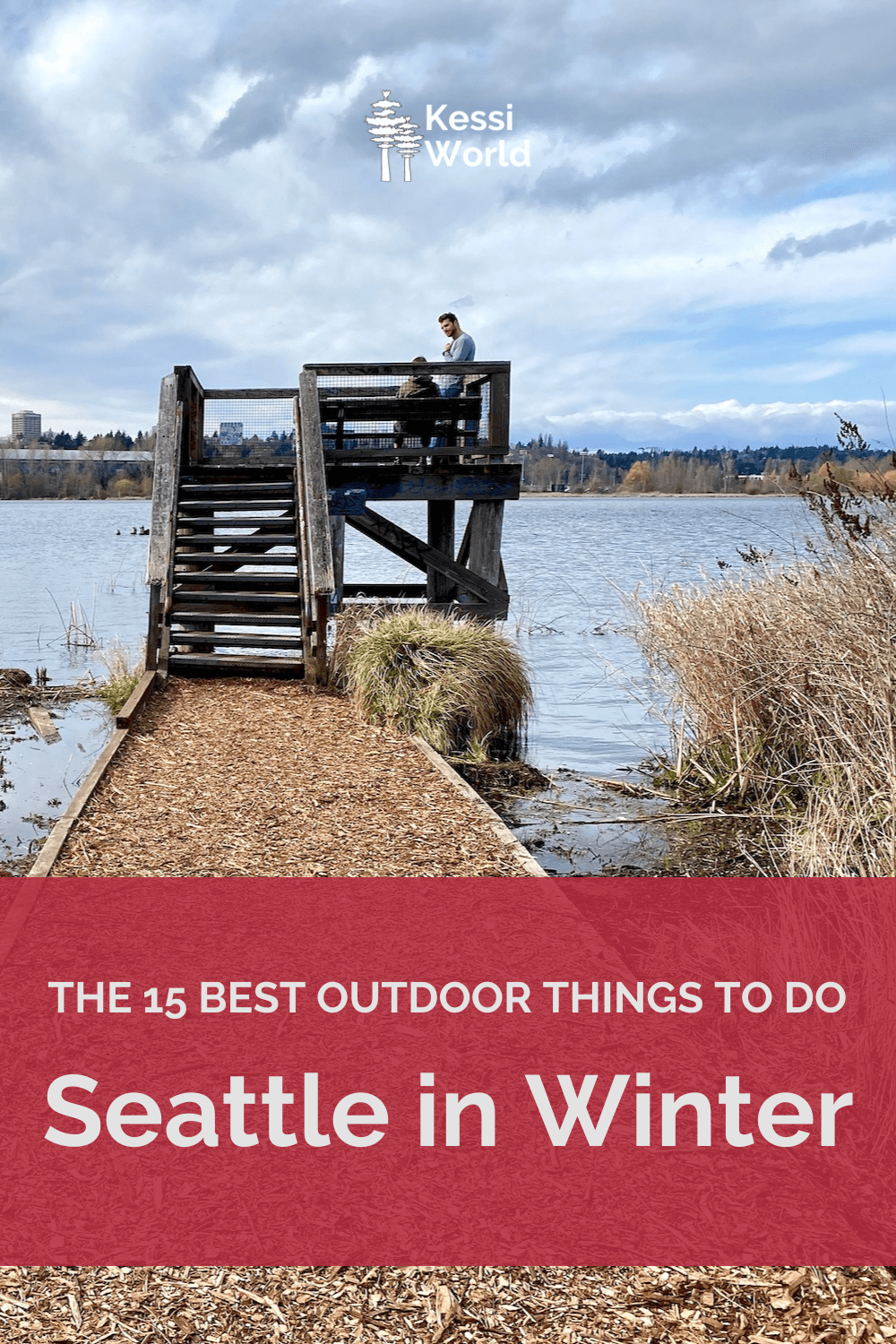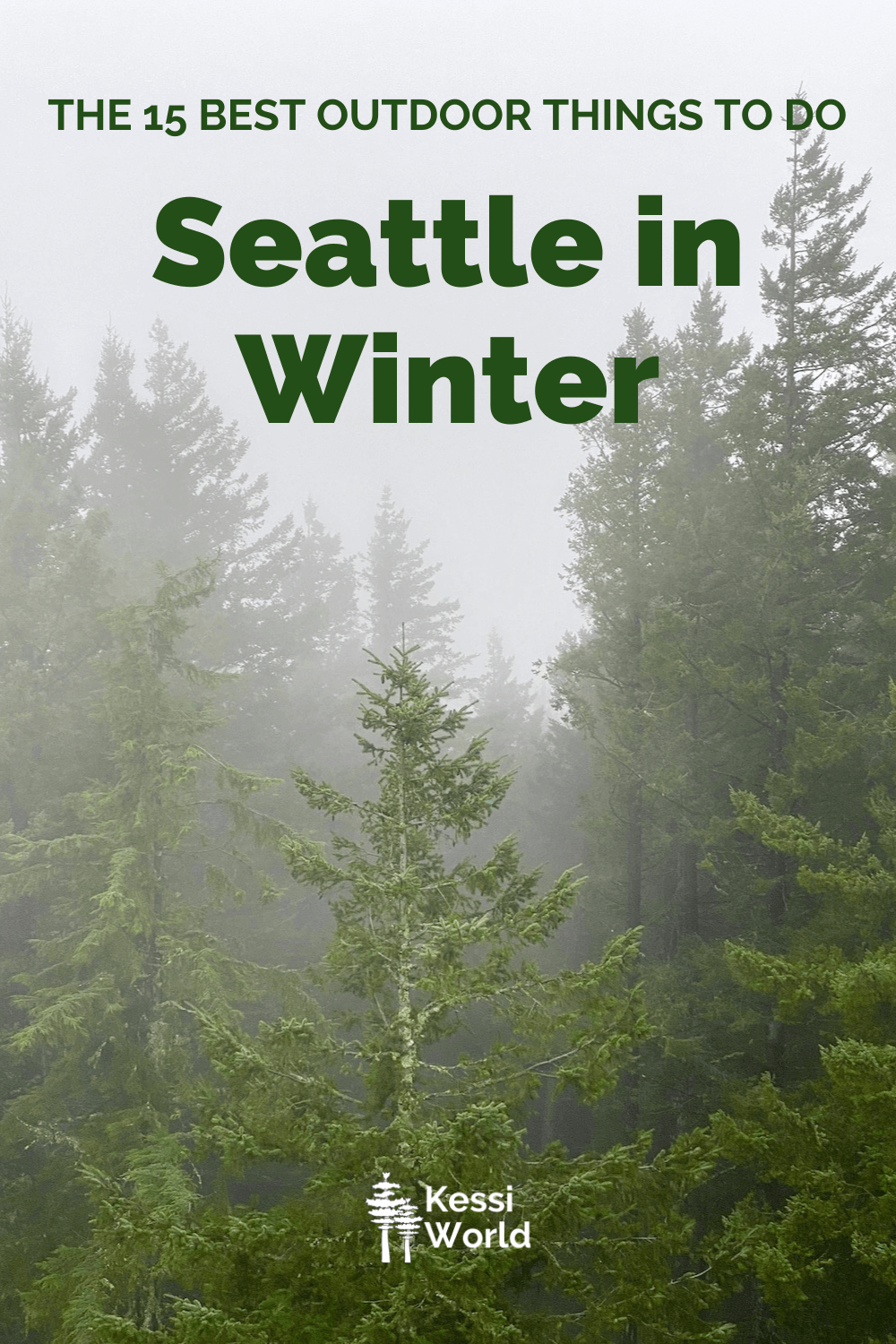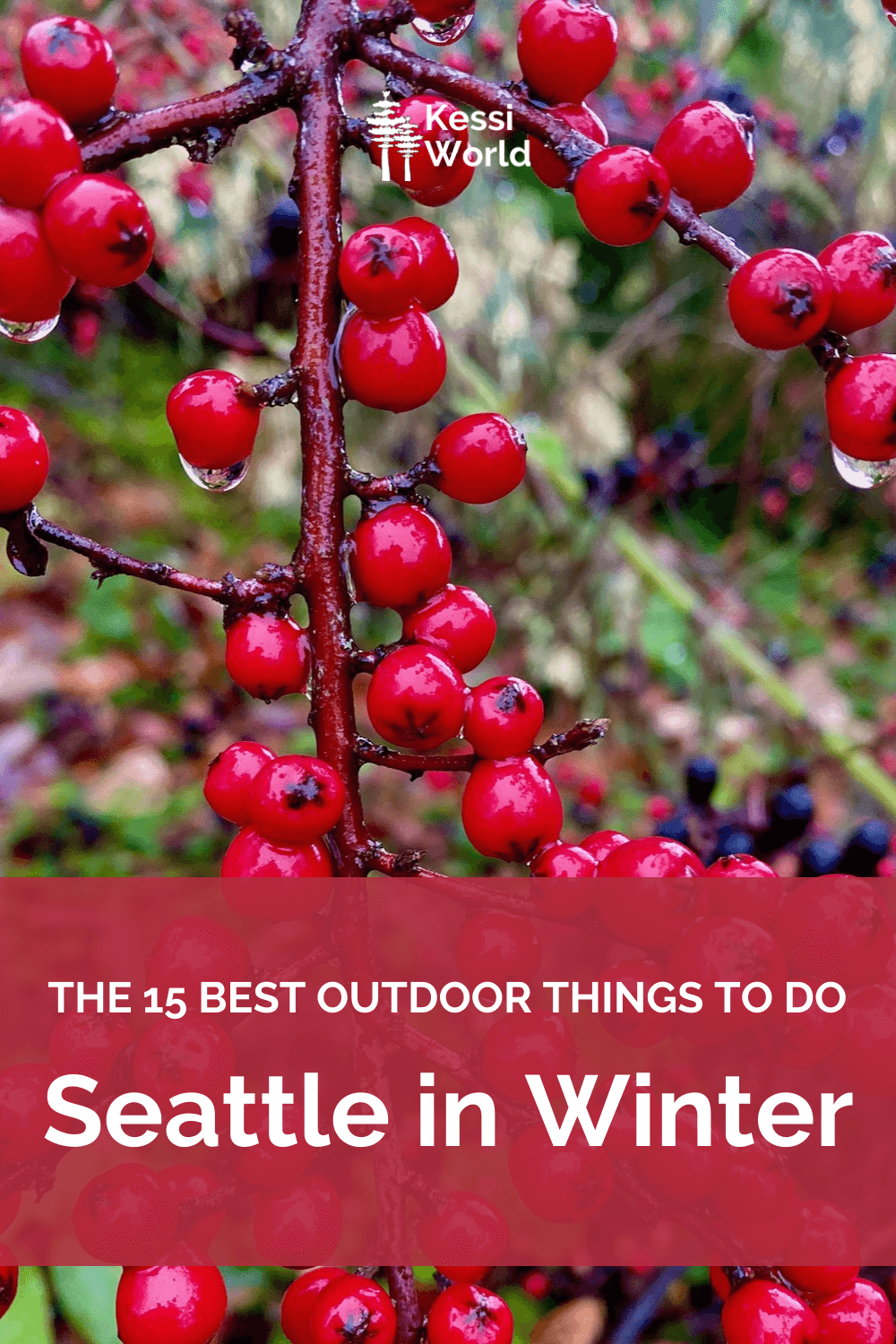
Seattle may be best known for our well-watered greenery, particularly during the darkest, dampest time of the year. Thoughts of moss practically growing underneath the shoes go hand in hand with brooding coffee shops and entire garment industries supporting waterproof everything. No, we don’t use umbrellas — thank you! And, while I’ve written about Spring flowers as a salve to the soul, the best (Summer) botanical gardens, Fall frolicking at Bloedel Reserve, or even Seattle in November, Winter offers a particularly special lineup of inspiration in the Emerald City. In a special mystical Pacific Northwest way — even in seeming hibernation — there are many fun outdoor things to do in Seattle in Winter.
This article offers my 15 favorite winter outdoor things to do in Seattle
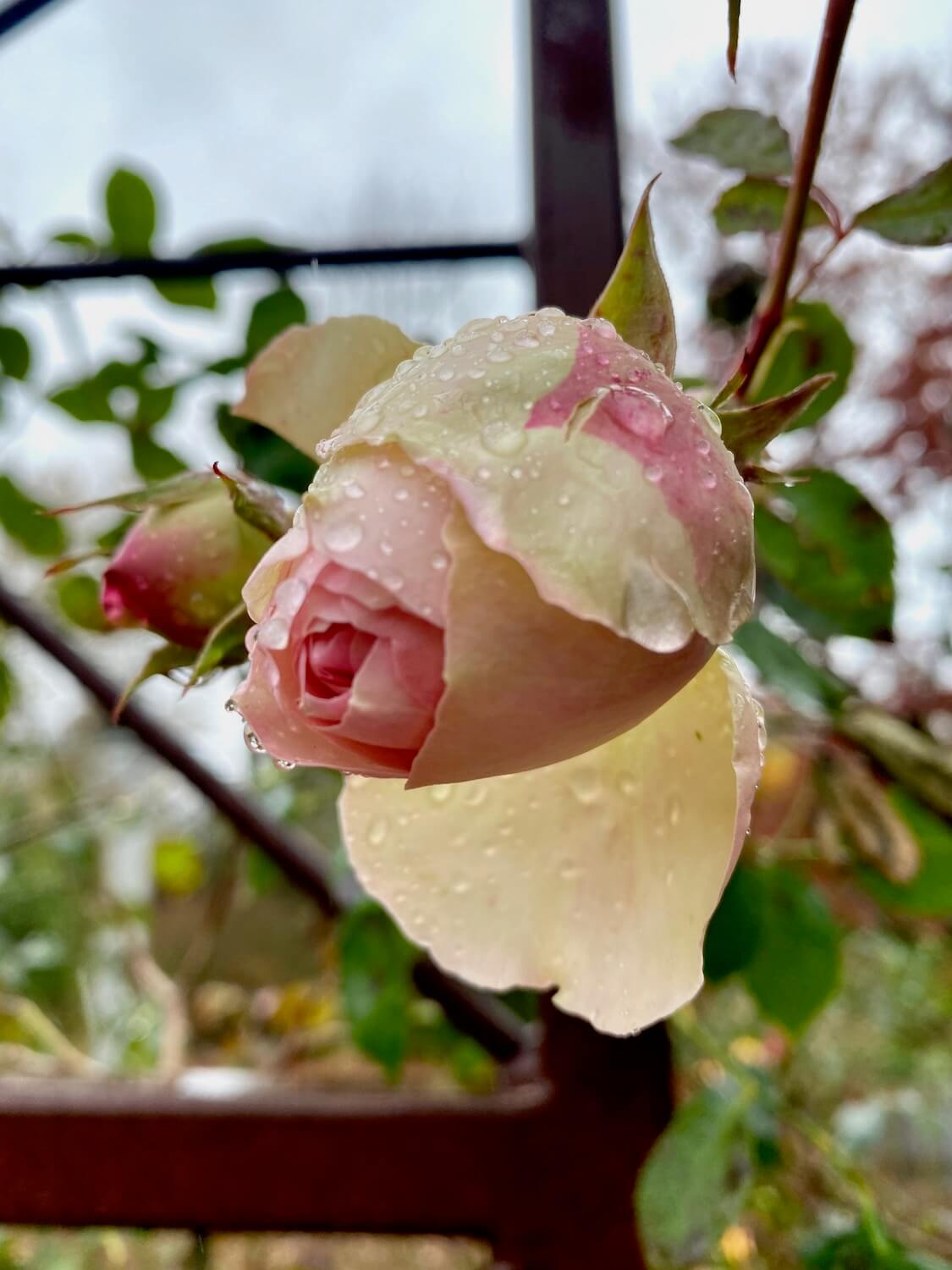
Wings clipped by the coronavirus pandemic, I’ve focused on exploration around my Seattle home this year. No matter the season, I find extraordinary inspiration in the green and blue spaces that range from Japanese inspired gardens to the vast Salish Sea tides flowing through the seasons with ease. The Winter months bring challenges of mud and decaying leaves clinging for dear life to the souls of hiking shoes and a bone-chilling wet mix that can challenge even seasoned locals. But don’t be deterred, the Winter season is fewer people with subtle beauty that makes the warm latte taste even better after a day out with the sea grass and shiny rocks of nature. So, put on your Gore-tex and waterproof shoes and join me with these fantastic outdoor Seattle Winter things to do.
Winter weather in Seattle — what to wear
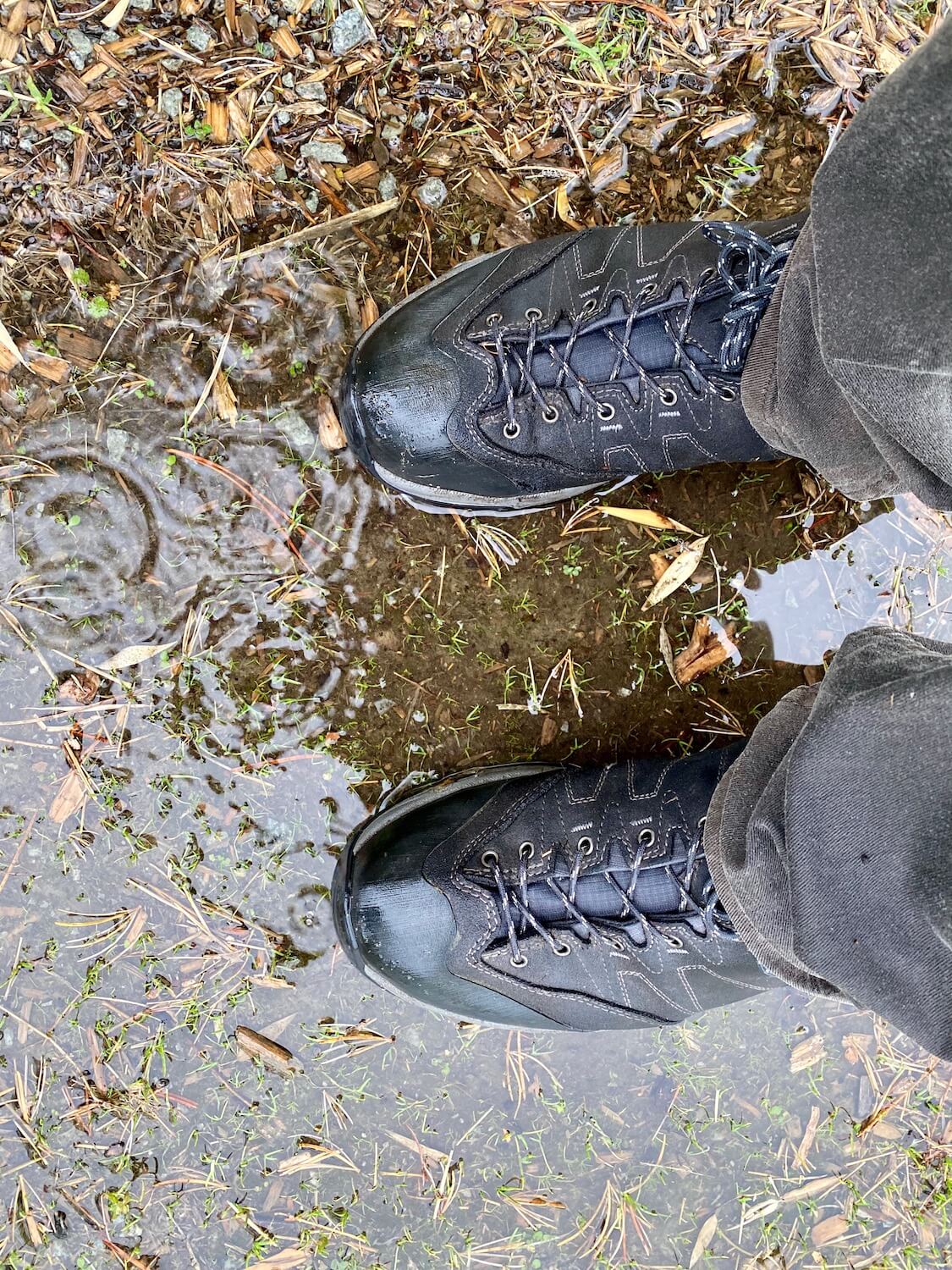
Contrary to popular stereotypes, it only really rains in Seattle half of the days in the deep Winter months of November, December, January and February. However, it’s the constant gray skies that can dampen the spirit, which underscores the importance of connecting with the outdoors. The maritime layer of humidity is such that the constant temperatures — that only vary a few degrees between 39F and 47F — chill the bones in very different ways than other parts of the USA. It’s important to wear a variety of layers during the day that can easily be removed as the weather will undoubtedly change a few times. A base layer (I like lightweight silk or SmartWool) is essential and a waterproof jacket compulsory. Waterproof pants can be helpful but I don’t wear them much when traversing the city. Another important consideration is to be aware that while 40F may seem cold, a heavy winter parka will be way too warm on most days in Seattle. As such, I prefer to layer up with a button down shirt and sweater with a light waterproof shell to keep out the moisture. “Cap” it off with some sort of beanie and finally, get a very good pair of waterproof walking shoes — hiking boots might be overkill in the city.
Winter activities in Seattle — three distinct options
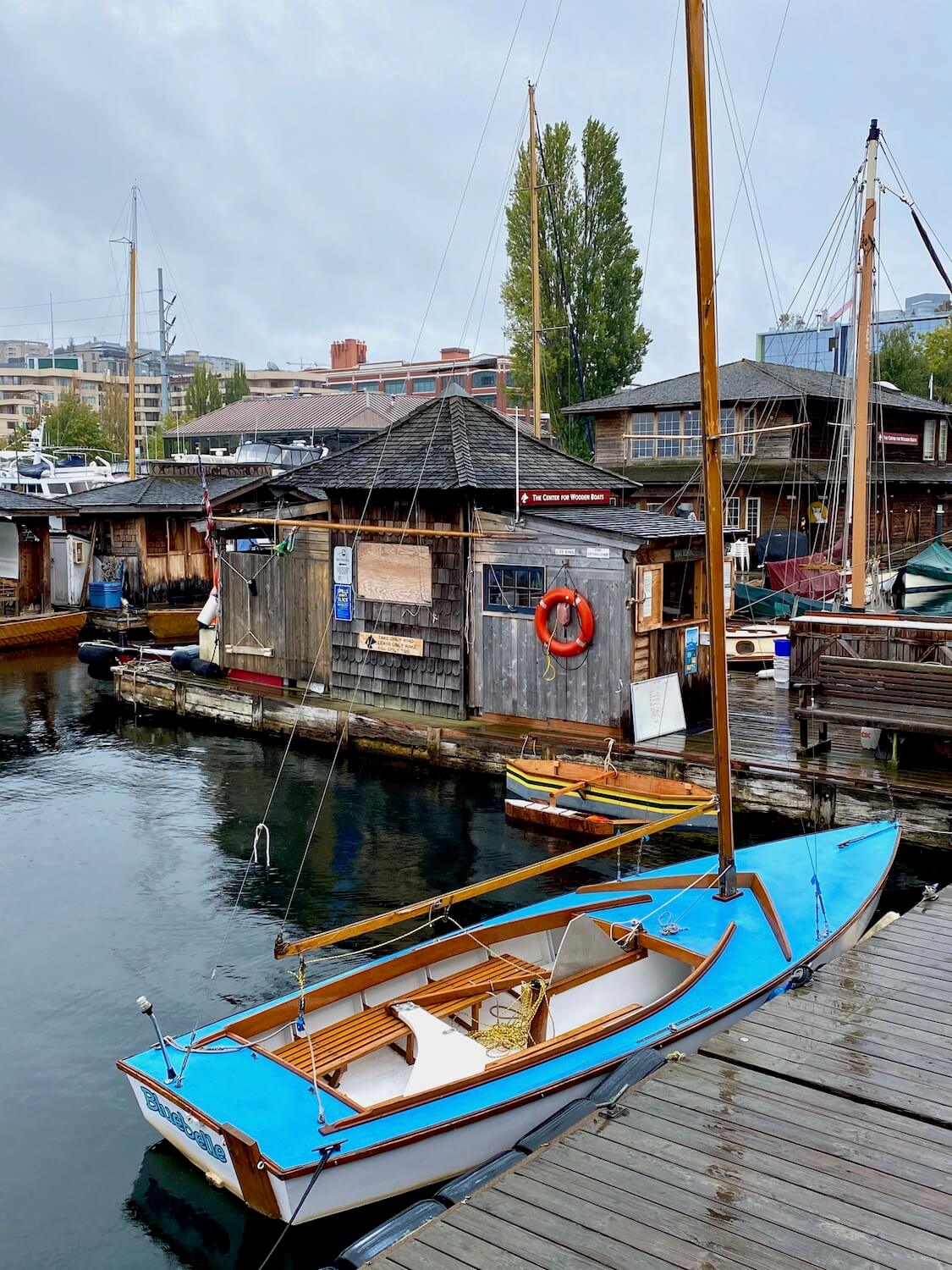
The Winter world in Seattle will be different this year, as famed coffee shops only serve to-go orders. Beloved cozy restaurants and bars that inspire walking through the rain to a warm, dry reprieve will oscillate between various pandemic requirements — relegating the hardy to take out at a nearby park while holding a hot “to-go” beverage. But despite the awkward logistics around indoor options, the outdoor world of discovery exists in three distinct groupings. Parks (marked in green on the map below) are always open and great for social distancing. Some can be quite muddy, so I’ve selected the best Winter options, given the hibernating nature of trees and plants in the Pacific Northwest. Water has cleansing, inspiring properties any time of year, and this section (marked in blue) provides my favorite public strolls. Finally, Seattle is alive and well with outdoor art and these highlights (shown in red) feature the famous brooding grit of the Emerald City — along with a few iconic installments. The Google Map has more detail and a few additional items not described in the sections.
The best parks to enjoy Winter outdoor things to do in Seattle (Green)
- Kubota Gardens
- Bellevue Botanical Garden
- Washington Park Arboretum — UW Botanical Gardens
- St. Edward State Park
- West Hylebos Wetlands Park
Seattle shorelines nourish the soul any time of year (Blue)
- Driftwood Sculpture Walk — Lincoln Park
- Alki Beach — West Seattle things to do in Winter
- Arboretum-Waterfront Trail — Foster Point
- Evergreen Point Floating Bridge — Highway 520
- Elliott Bay Trail — Centennial Park
Expressive art — Outdoor Seattle Winter things to do (Red)
- Olympic Sculpture Park
- International Fountain and art of Seattle Center
- East Portal Viewpoint and pedestrian tunnel to Sam Smith Park
- The Fin Project at Magnussen Park and Sound Garden
- Art of the CHOP — Seattle’s Capitol Hill — outdoor Winter things to do
The best parks to enjoy Winter outdoor things to do in Seattle
There’s no doubt that Seattle parks are showstoppers with the fresh Spring, abundant Summer and vibrant Fall botanicals. I write about the Best Botanical Gardens, P-Patches (community gardens) and Places to View the Seattle Skyline in other articles, which highlight a number of parks — many of which also provide enjoyment and views in Winter. It’s important to enter this section with the understanding that when the colors fade and Winter sets in, the experience is about the quietude of nature taking a pause to regenerate. In this setting, evergreen trees provide the color varieties along with berries and rose hips, offering contrast to bare branches of the deciduous varieties, criss-crossing the landscape. The following collection is my list of favorites to enjoy the damp, contemplative world of Winter in Seattle.
Kubota Gardens

This space gracefully fuses formal Japanese Garden elements with materials prominent in the Pacific Northwest — and the combination works, any time of year. Since the official Seattle Japanese Garden closes for Winter, this is a great option to soak up the balanced energy so famously provided by Japanese Gardens. The Winter season is less colorful for sure, but the textures of evergreen trees fold in amongst bamboo thickets while water flows from waterfalls into quieter pond spaces. The 20 acre plot boasts 9 ponds crossed by two red bridges and 140 varieties of maples — with twisting Winter branches inspiring movement in the quiet. My favorite spot in the entire garden is on a bench under a giant cedar tree that seems to protect me from everything in the outside world. The grass can be a little muddy, so be careful to stay on the paths, but there is plenty to experience here in Winter. Formerly the private garden of Fujitaro Kubota, this refreshing oasis in the Rainier Beach area of Seattle is now part of the city park system and is free to enter.
Bellevue Botanical Garden
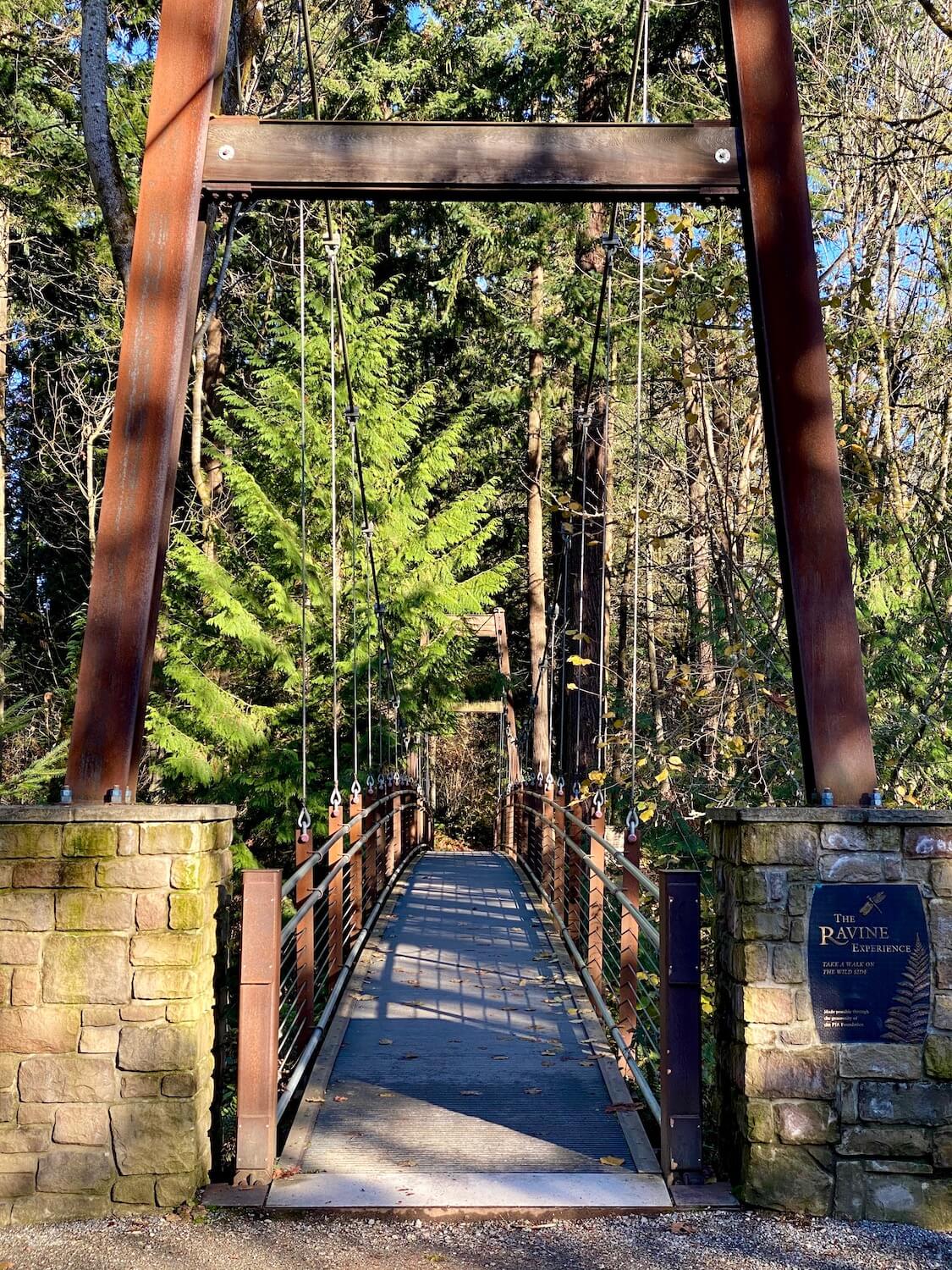
The Bellevue Botanical Garden is a fantastic experience any time of year. I love the rock garden, which comes to life with the autumn storms and offers a variety of interesting plants. Wander amongst the gravel paths and ascend the strategically placed stone slabs to the original mid-century style residence of Cal and Harriet Shorts, who generously deeded the land to start this garden in 1981. Much of the flower beds that produce flowing colors all Summer lay dormant in Winter, but do not fret. Continue on a path through the forest environment that passes by the little “Hobbit” door etched into a shallow bank where Mr. Shorts wintered his bulbs. Explore the delicate balance of the Yao Japanese Garden before wandering further into the forest through reclaimed native wetlands toward a full size suspension bridge that seems to magically float above a deep fern and rhododendron covered ravine.
Washington Park Arboretum — UW Botanical Gardens
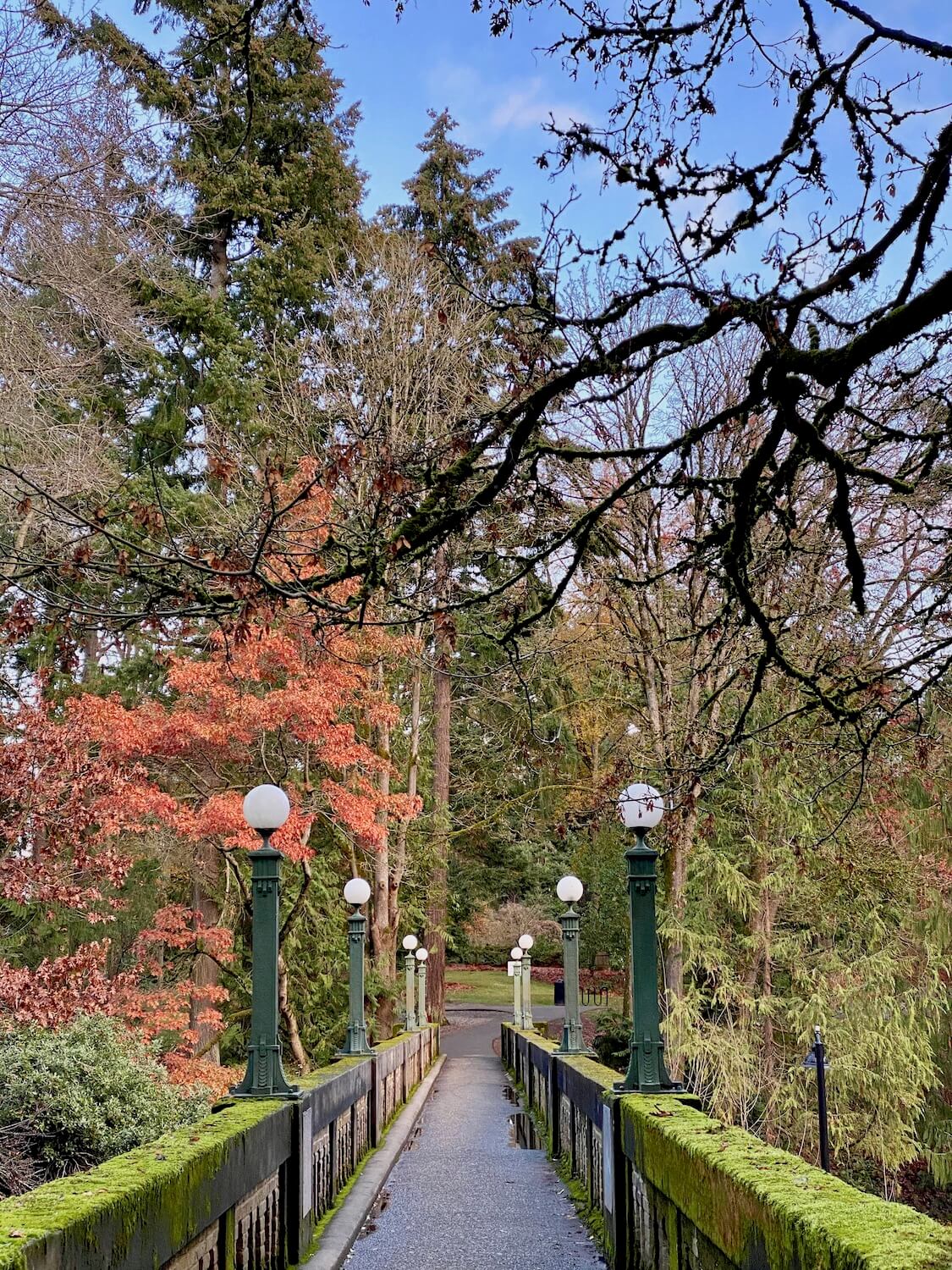
This vast expanse in the central Madison Valley neighborhood of Seattle is well-known for providing numerous options to explore on well maintained paths. A paved beltway wraps around the perimeter and more intricate wood chip trails wind through an internal maze-work of staircases weaving together interesting plant zones. The space lends well to Winter exploration, as most surfaces remain dry enough to navigate without wet feet. Follow a ridge of evergreens that range from redwoods to unique varieties of pine to western red cedar and take in the smells of the sinewy bark as moisture in the air glides down the waxy needles working to produce baby seedling cones. The Seattle Japanese Garden (closed November to March) is in this complex as well as the Arboretum-Waterfront Trail (mentioned below). Be sure to find the Arboretum Aqueduct (pictured above) and follow the moss covered railings to a hidden part of the park that showcases an interesting assortment of trees, like one of my favorites, the monkey puzzle.
St. Edward State Park

Long ago my great uncle attended seminary at this Catholic academy — which is now a Washignton State Park — and the spiritual vibe remains. The former grotto dedicated to Mary is no longer “official” but still a very spiritual place to meditate amongst the intricate brick and stone walls framed in with moss, ferns and other things green. Continue down the hillside under a tall canopy of leafless maples and evergreens to the banks of Lake Washignton. The gentle sounds of water lapping onto the tiny pebble beach help create a beautiful Winter retreat. The seminary buildings are currently under renovation to become The Lodge at St. Edward, a full service hotel space — expected to open in Summer 2021. Remember, since this is a State Park a daily parking pass ($10 via automatic machines) or a Discovery Pass ($30 where you buy hunting licenses) is required to utilize the ample parking area.
West Hylebos Wetlands Park
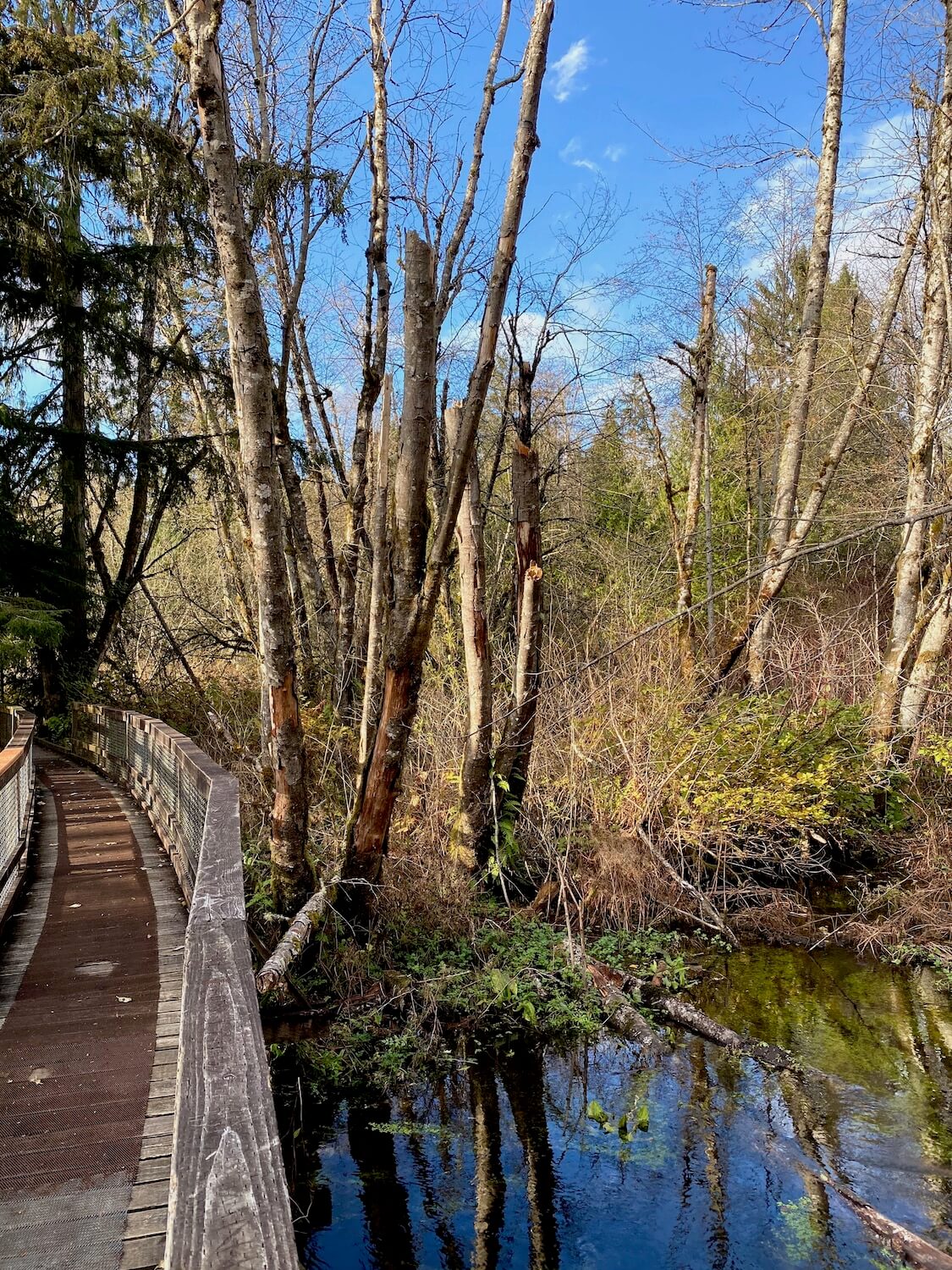
This is a recent discovery for me — in the dead of Winter — that feels like a magical portal to another world. The 120 acre wonderland is the kind of place that remains embedded in the heart long after a visit. Don’t be deterred by the busy, uninspiring suburban thoroughfare leading from Interstate 5 toward the sprawling neighborhoods of Federal Way. Look for an awkward renovated log cabin — built by the Denny family (first European settlers in Seattle) — which was moved from the original location near Lake Union in Seattle. The parking lot will not reveal much about the experience, but keep the faith. Continue through to find the series of raised wood planks that lead to a 10,000 year-old sink hole, an ancient sitka spruce tree and finally, a peaceful pond surrounded by a mixture of old growth evergreens and ground covers that come to life in the marshy conditions here. This is a perfect activity in the rain, which seems to cast a mystical spell over the area — just be careful not to slip on the planks!
Seattle shorelines nourish the soul any time of year
Water is ample in every direction around Seattle — any time of year. That’s what keeps our world green, even in the warmth of Summer, or, dead of Winter. While there are plenty of great places to access walks along the water, those listed below are my absolute favorites. I’ve also placed a few additional options on the map above. Be sure to bundle up, because the wind can be stronger near the shore and moisture is everywhere. When considering a saunter along the Puget Sound (Lincoln Park & Alki Beach below) be sure to research the tides, as they can change as much as 14 feet between low and high marks. Otherwise, the lake levels stay pretty constant.
Driftwood Sculpture Walk — Lincoln Park
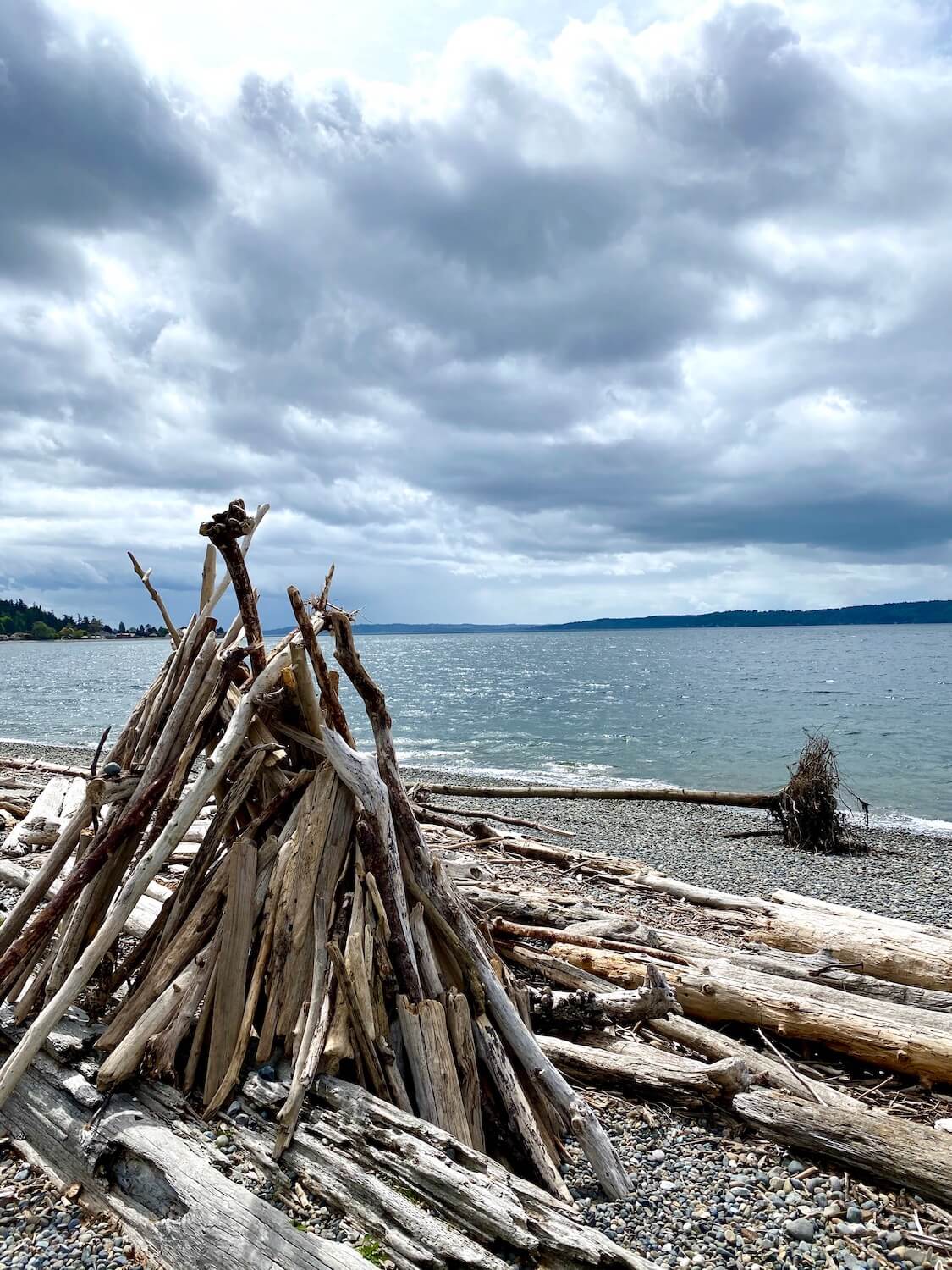
This West Seattle experience is soul nourishing in any weather. Keep in mind that while the name might imply a formal art installation, the sculpture walk is all about nature’s bounty of wood from the ocean, drifting onto the pebble beach, and then assembled into make-shift shelters that rise up amongst the rocks and larger logs. The path makes a crescent shape along the Salish Sea, with views of the Fauntleroy to Vashon Island ferries efficiently shuttling island-goers back and forth. The Olympic Mountains could decide to show up for a few minutes on a clear day, but otherwise expect a wintry blend of gray dramatically hovering in the sky above deep green seawater folding onto the shore.
Alki Beach — West Seattle things to do in Winter
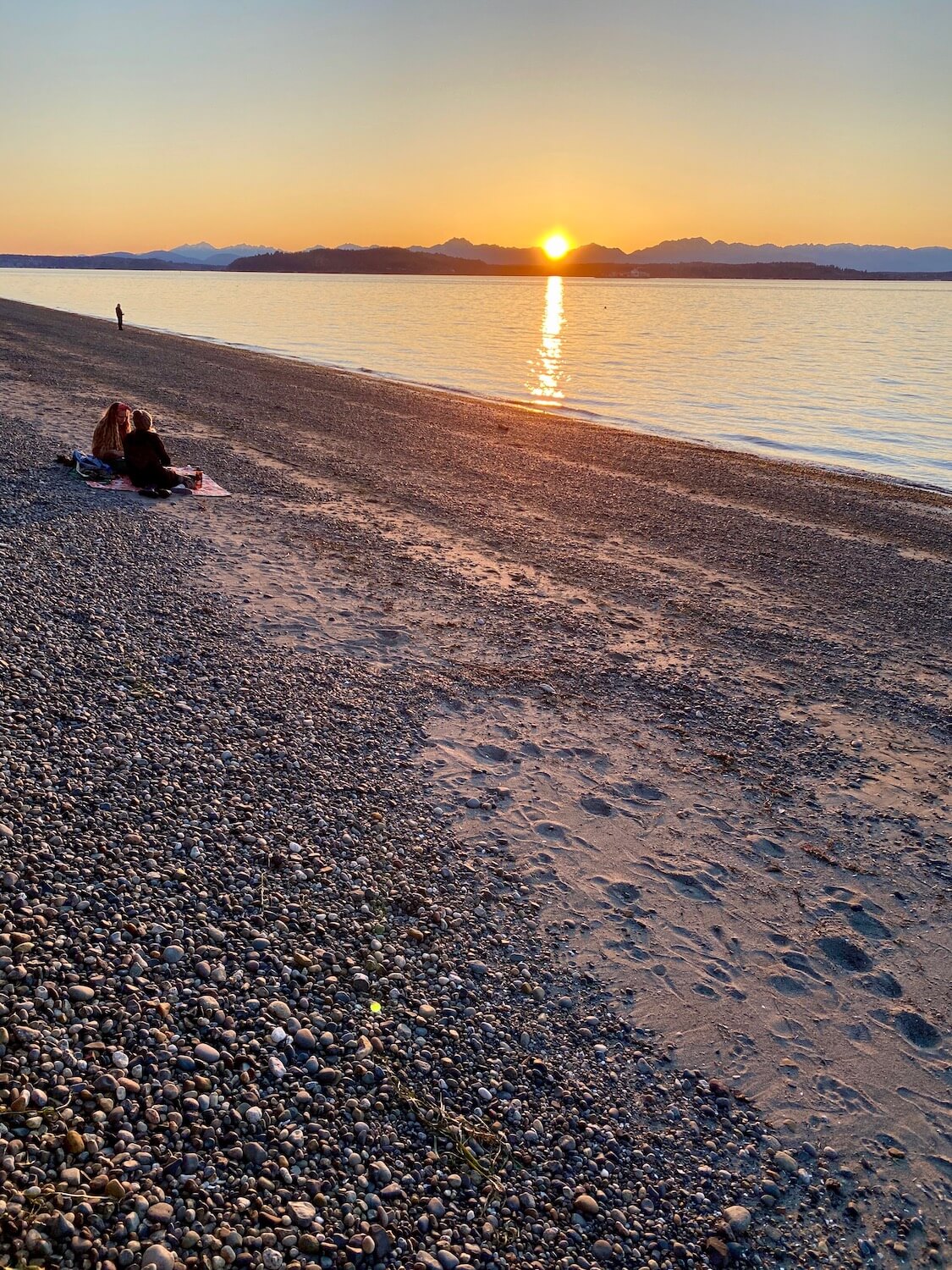
I love Alki Beach (Al – Kai) and West Seattle so much I write about this fantastic waterlogged peninsula in another article: The best things to do in West Seattle, including Alki Beach. While the hustle of volleyball, bikes, roller blades, picnics and paddle boards definitely rolls much slower in Winter, this stretch of beach and boardwalk is full of life and interesting things to see. I recommend parking near Luna Park, which has views both of the Seattle Skyline and the Olympic Mountains (on a clear day). From here stroll toward the busier part of the promenade. The lighthouse at the end of the spit is walkable along the beach at low tide, but check the tides to avoid getting stranded. There should be plenty of to-go options for coffee or snacks if the blustery weather inspires a warm cup to carry in hand.
Arboretum-Waterfront Trail — Foster Point

This experience reminds me of duck hunting with my brother in the middle of Winter — amongst cattails and other marshy plants soaked with moisture — except you’re viewing the birds instead of shooting them. It’s possible part of the trail will involve thick mud, so be sure to wear appropriate footwear — probably boots. There is something liberating about trudging through the mud amongst a dormant marsh while taking in the variety of animal life and absorbing the stillness of Union Bay, which is an alcove of Lake Washington. Start out at Foster Point, with benches and rocks that frame in the lake while stray geese wander about. The plank system begins here and continues through a system of brush and elevated viewing stations. The trail ends at East Montlake Park, which is still in transition from the development of the new Evergreen Point Floating Bridge (described below). Unless the desire is to continue to the bridge, it’s a more pleasant experience to back track on the plank system.
Evergreen Point Floating Bridge — Highway 520
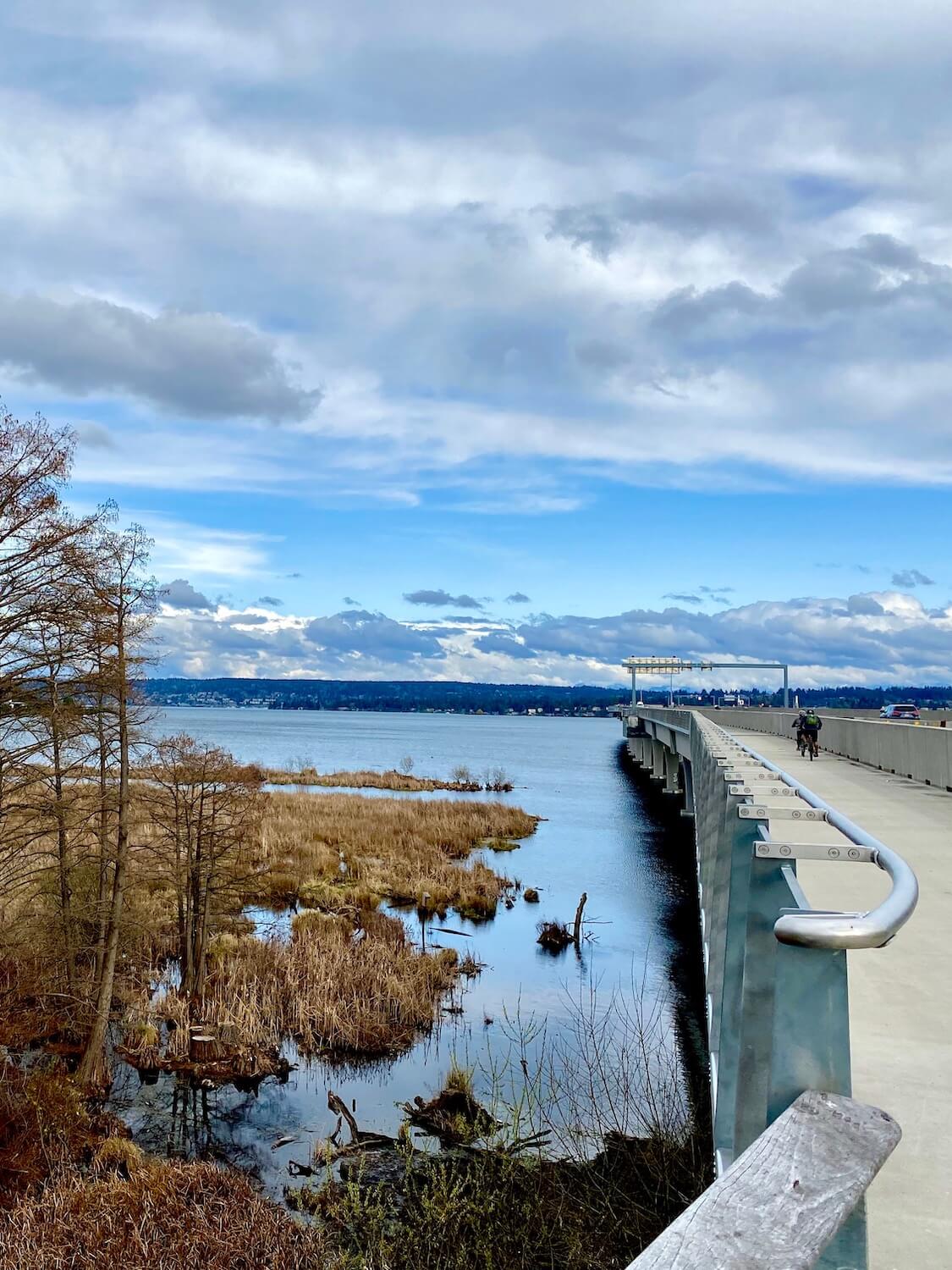
Seattle is unique in that we have two engineering marvels — floating bridges — hovering over deep, freshwater, Lake Washignton. The Evergreen Point Floating Bridge serves to connect the University of Washington area of Seattle with Bellevue, under the Highway 520 moniker. The bridge is only a few years old and was built with more attention to pedestrian and biking options — well protected from the whizzing vehicles. The northern side of the system of giant floating tanks offers a spacious option to cross the bridge. Starting on the University of Washington side of the lake, near East Montlake Park, notice the swampy ecosystem from viewpoints that peer down to the Arboretum-Waterfront Trail (mentioned above.) Continue over the water, stopping peridoically at the rest spots where placards offer information about all things Lake Washington and Seattle. The walk is about three miles (one hour) in each direction and ends at 520 Bridge View Park. If “the mountain is out,” as we say in the Pacific Northwest, this expedition offers an amazing treat.
Elliott Bay Trail — Centennial Park
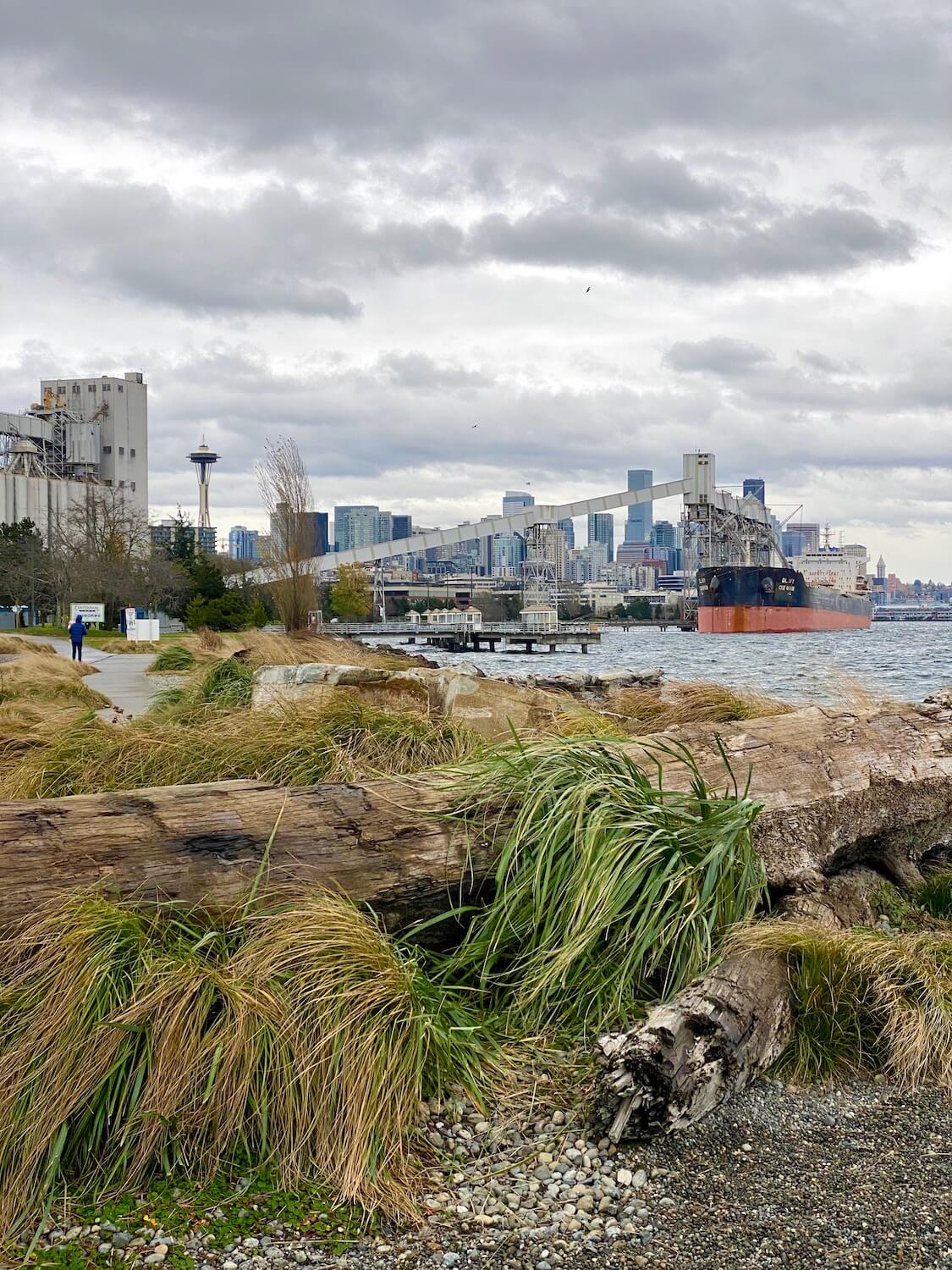
Reclaimed from heavy industry in the 1980’s, this inspiring series of bike and pedestrian pathways connects visitors with the best elements of Seattle. Work continues to update the shoreline that shares space with the vibrant dark green water of the Salish Sea — new beaches are being formed to help support more natural habitats for salmon and other water-life. Start at the Olympic Sculpture Park (mentioned below) near Pier 70 and continue for about 1.5 miles to Elliott Bay Park (photo above). Even if the breathtaking views of the Olympic Mountains are not present, the moody scene of Winter clouds flowing over an urban mix of industry, ships and famous skyline icons serves up a cornucopia of Seattle spirit deeply connected with nature. Bundle up, because there is no protection from the elements on this three-mile jaunt.
Expressive art — Outdoor Seattle Winter things to do
Seattle has a rich art culture that’s alive in formal museums, architecture, outdoor exhibits and wall murals. More recently, the events of 2020 brought about a new edge to the art expressed in the city — atop plywood window coverings and vacant brick walls — associated with energy from the closing of business for the coronavirus pandemic and then, later, Black Lives Matter protests. The Google Map above includes more options not mentioned here, like the Hat & Boots Park in Georgetown, but the following are my favorite places to experience Seattle art in Winter.
Olympic Sculpture Park

The setting of this narrow landscaped patch, infused with a variety of thought provoking exhibits, could barely be matched on a clear day. The front row view of the Salish Sea is soulful in any weather, but on a clear Winter day when the snow-capped Olympic Mountains emerge in all their grandeur it’s hard not to feel the delicate balance that exists between city and nature. Wind through the diagonal pathways that meander through casts of metal with teetering objects and grasses planted in strategic places, bringing to life the feeling of wandering through the dunes at the beach. The Space Needle hovers above this scene, remaining in the background. From the nine-acre park take the pedestrian walkway over the railroad tracks to meet up with Elliott Bay Trail — which changes direction North along the sound as far as you fancy (featured above).
International Fountain and art of Seattle Center

The Seattle Center was originally created to house the 1962 World’s Fair — firmly launching the iconic Space Needle into the city’s identity. A whole cluster of futuristic pavilions were constructed for the event that showcased all the space-age technology that would build the future of the world. Most of the original buildings were dismantled, but a few remain, such as the mid-century gem that houses the Pacific Science Center and the sporting arena with a roofline resembling a ceremonial hat worn by traditional Salish tribes. I enjoy strolling through this hodgepodge of architecture because artwork seems to pop out from every direction. Look for giant daisies extended up toward the Space Needle or the effervescent curvature of the Museum of Pop Culture’s metal exoskeleton. Continue wandering through the collection of buildings to the giant round ball wedged in the bottom of a sloped concrete basin — like a pinball waiting to drop through a hole. The massive spray of water shooting from various conduits around this giant ball inspire a child-like interest to run through the streams of mist and spray. An activity perfect for a rainy day — but this time an umbrella might be useful.
East Portal Viewpoint and pedestrian tunnel to Sam Smith Park
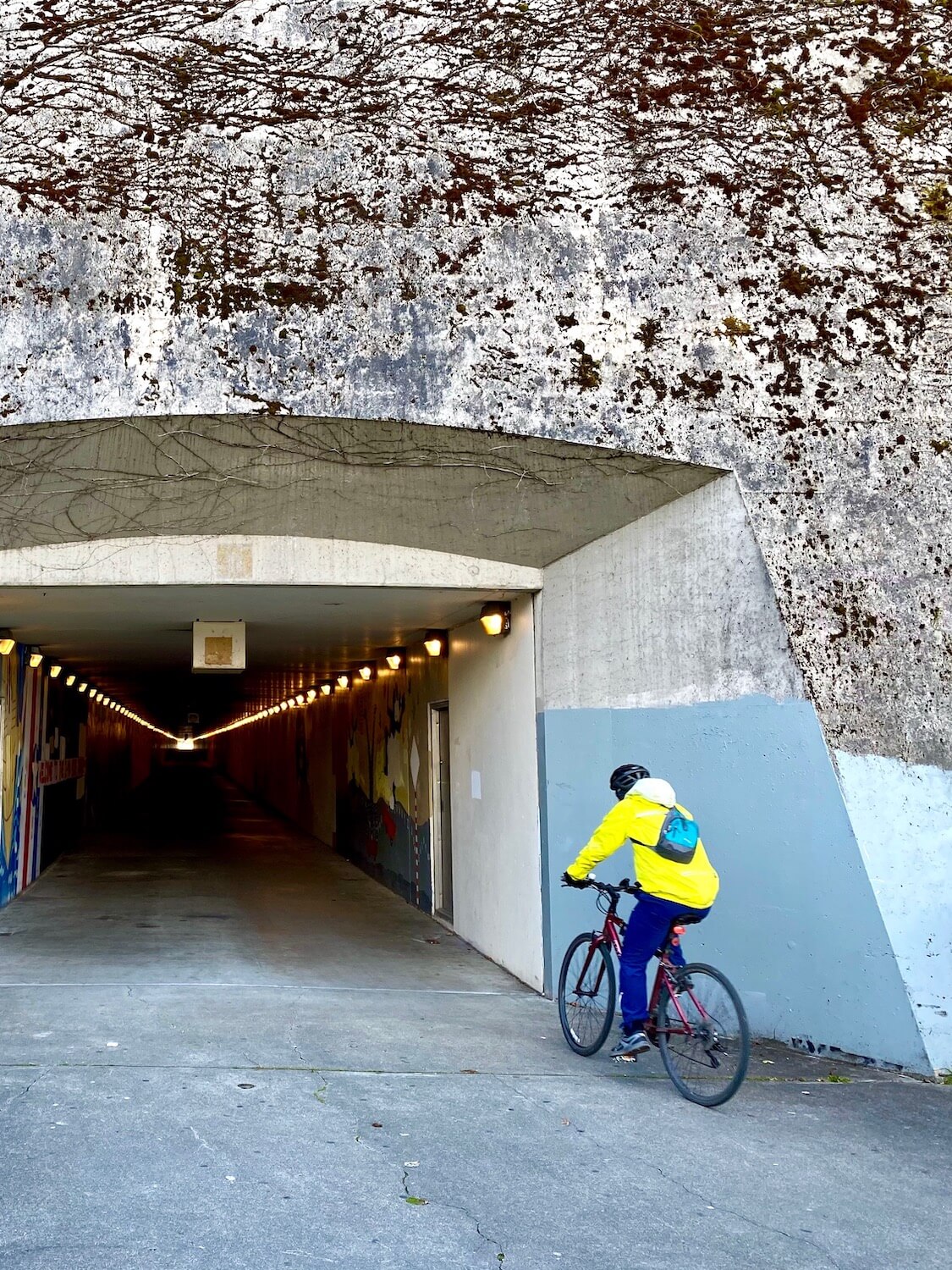
The East Portal Viewpoint offers wide glances East toward the snow-capped Cascade Mountains and skyline of Bellevue. Let the drumming of traffic on busy Interstate 90 below create a trance as the abundant Lake Washington seems to float in surround sound. Start at this park, take in the views and continue through a pedestrian/bike tunnel that may seem as if Berlin is right around the corner. The tube is a popular avenue with locals and the art frolics on the walls throughout the space. At the other end of the tunnel, enjoy the features of Sam Smith Park before getting the heart rate up on a series of steps that ascend to 31st Avenue South. A little pocket of commerce offers a coffee shop across from a sweeping view of the skyline of Seattle. Wind back down the hill, heading east, exploring the interesting architecture of homes chock full of million dollar views.
The Fin Project at Magnussen Park and Sound Garden
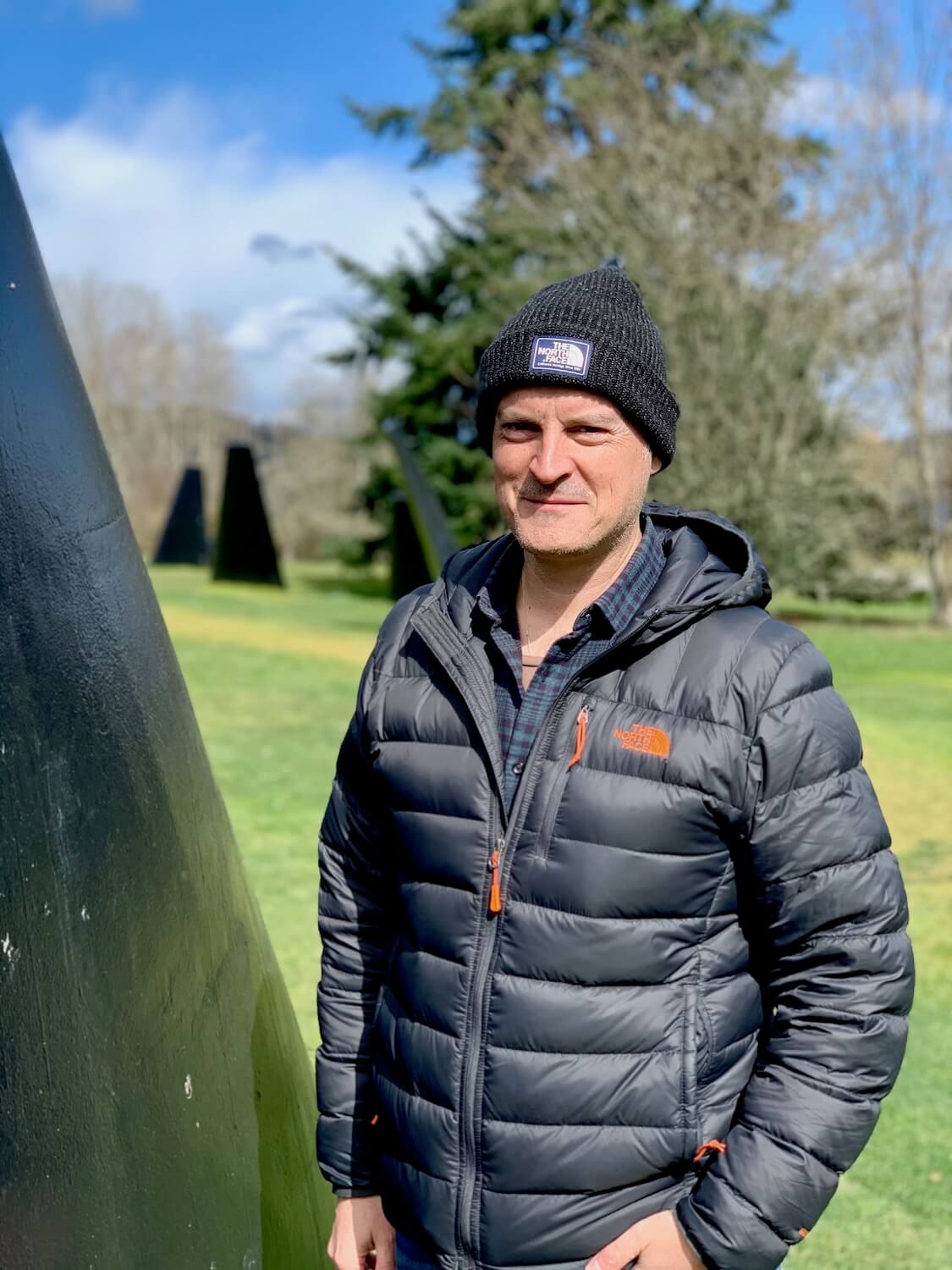
Magnussen Park has many components that could belong in any of these three categories. There is also an off-leash dog park here. My favorite area of the park is “The Fin Project,” by John T. Young — an ingenious collection of fins from decommissioned nuclear attack submarines popping from a grassy space set between Lake Shore Promenade and a rolling hill popular for flying kites. The collection is designed to resemble a pod of Orca whales swimming through the Puget Sound. As a bonus, check out the collection of pipes and wires that form Sound Garden, a sculpture inspiring the name of the 1990’s Seattle rock band. The entrance is just North of Magnussen Park through the National Oceanic and Atmospheric Association (NOAA) campus.
Art of the CHOP — Seattle’s Capitol Hill — outdoor Winter things to do

I’ll close with the art of my own neighborhood — Capitol Hill — which consists of a mix of long-time murals, pandemic plywood coverings and expression associated with the Black Lives Matter protests that started in June 2020 after the murder of George Floyd. I present a real-time account of the art in a photo essay written in June 2020 titled, Art of Seattle CHOP. CHOP stands for Capitol Hill Occupied Protest and consisted of a small portioned area in the heart of Capitol Hill near the Seattle East Precinct Police Station. While most of the temporary installments were removed, much still remains on the sides of buildings and in other nooks and crannies. The large “Black Lives Matter” letters that emerged on the surface of East Pine Street last Summer were recently repainted and still invoke some of the fraught energy of the passioned movement. Similar to my feelings about places like Berlin, I feel it’s important to honor the meaning of the energy that inspired this protest — and visiting the art is one way to acknowledge our very recent Seattle history. Wander between Pine and Pike streets in this area with eyes peeled for all kinds of brilliant artwork. Businesses are still open — albeit with pandemic appropriate adjustments — and would appreciate any support for coffee to-go or outdoors dining. I like Cafe Vita for coffee and Poquitos, Lost Lake and Oddfellows Lodge all offer outdoor meal seating. Finally, while this area received a lot of negative press about burning cars and rampant crime, this is my home and I feel safe walking in this area — day or night.
Bonus — Ferry to Bainbridge Island
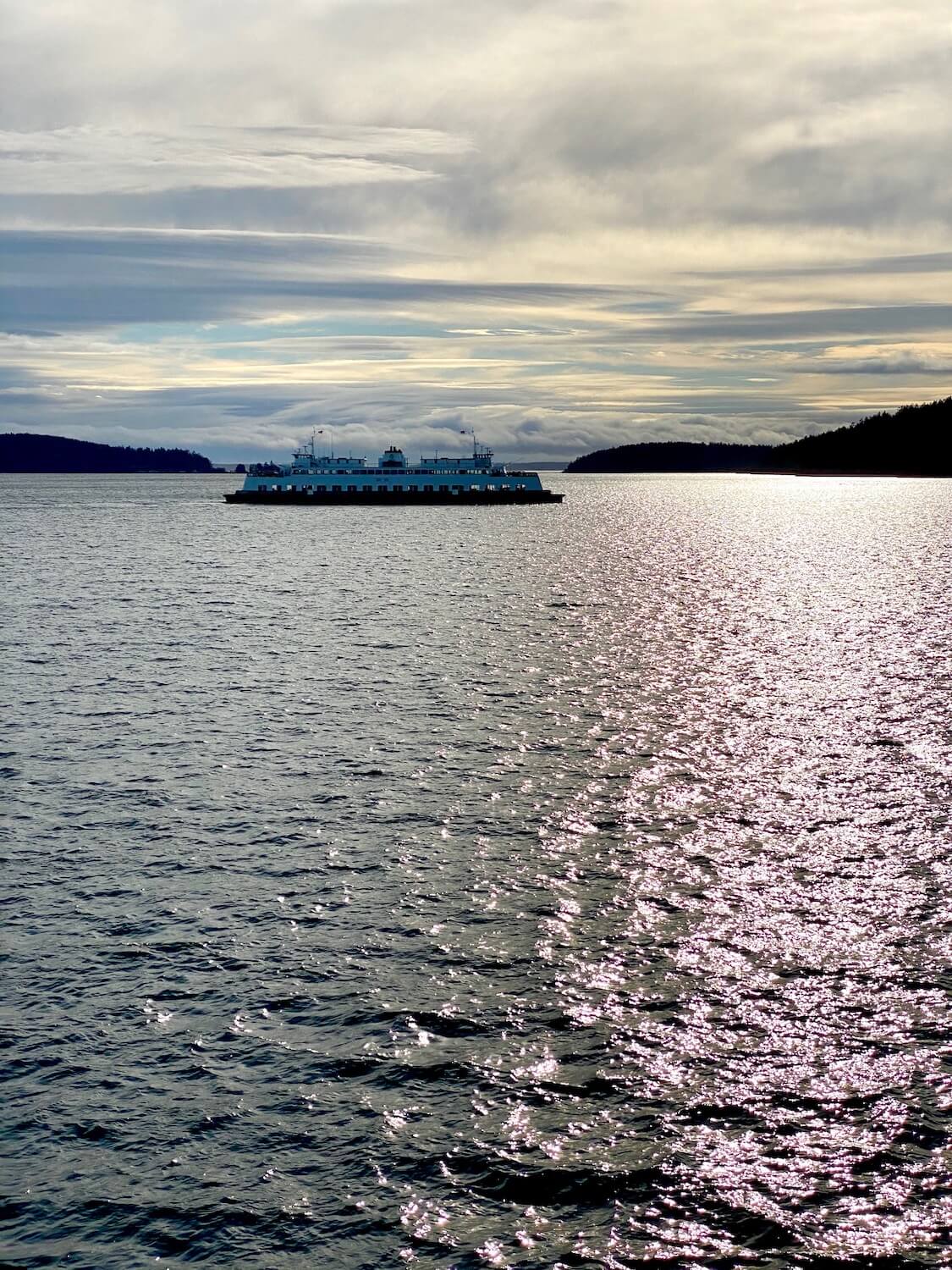
Not much beats floating through the Puget Sound on a ferry — no matter the weather. Walk onto either the Tacoma or Puyallup (yes, I’m geeky about airplanes and boats) at Coleman Dock in Downtown Seattle. At the time of this writing the passage costs $9.05 per person for the round trip. Machines sell tickets or ORCA (Seattle Transit) cards are accepted — right as you walk through the boarding gate. Since the fare is only sold as a round-trip, no tickets are taken when boarding the eastbound return to Seattle. Masks are required on the ferry and I spend all my time out on the deck, looking for kelp beds and the elusive Orcas. The skyline of Seattle is amazing as the boat pulls away from the city and about forty minutes later feel the bump of the marine vessel into the Bainbridge Island pilings. There are a few easy coastline walks from the ferry terminal, towards Waterfront Park & City Dock. Hawley Cove Park is about a mile away in the other direction but showcases wide views of the ferries and Seattle from a peaceful public beach. Winslow Way East offers a variety of to-go food and drink options, but I love the pizza at Bruciato — order the date prosciutto with drizzled balsamic. Ferries run frequently throughout the day, so this is an easy jaunt for lunch.
